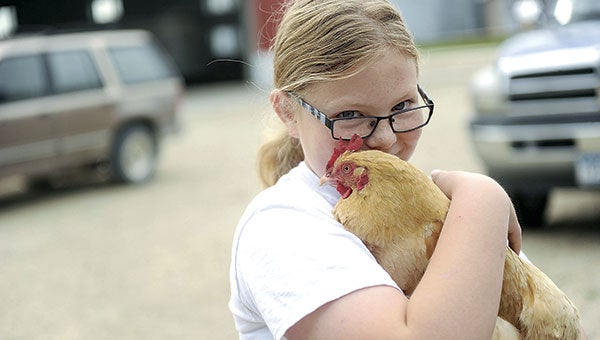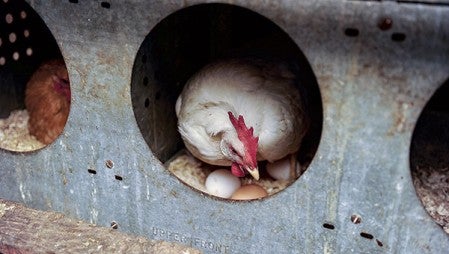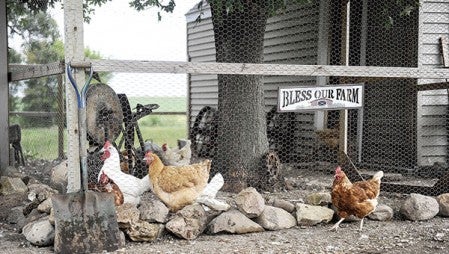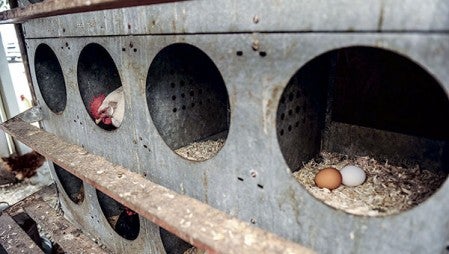Family hatches up lessons; Farm children raise chickens to show at fairs, sell eggs
Published 10:21 am Monday, August 31, 2015

Gloria Hanson snuggles with one of her chickens on the family farm south of Austin Thursday. Photos by Eric Johnson/photodesk@austindailyherald.com
Gloria Hanson, 11, loves her chickens.
“I like to hang out with them,” she said, holding one of her prized birds. “They’re nice and soft to hug.”
Gloria, along with her sister Victoria, 13, and brother Luke, 8, started taking care of chickens and eggs as a hobby, and now they’ve turned it into their own small business by selling the eggs to family, friends and even some businesses.
“It’s really fun,” Gloria said.
The Hanson family has about 60 birds and two roosters, which is down after some of their animals were killed by an area dog.
The family started raising chickens about three years ago after some 4-H friends showed chickens at the fair, and the Hanson children thought it would be fun to do too. Kaye Hanson, the children’s mom, explained when school was close to letting out for the summer, Gloria thought she would be bored.
“So we ordered our first chicks so she had chicks to take care of and [she] loved taking care of them,” Kaye said.
The family lives on a farm, as Kaye’s husband, Corey, grows soybeans and corn, along with some custom trucking. A neighbor gave the Hanson children a few chickens too, but Kaye said for her children to go through the process of raising them from chicks was a good learning experience.
“It’s a good animal science project for the kids,” Kaye said. “They learn how fast they grow, what kind of nutrition they need and things like that, but then also it is something where we have enough that they produce more eggs than our family can use.”
The children have split up the chicken chores in three different pieces, as Luke does a lot of the feeding, Victoria collects the eggs, and Gloria washes the eggs to get ready for sale. This also means they split the egg money between the three of them. The eggs are sold for about $2.50 per carton to friends, family and other assorted customers.
They even sell to some businesses, such as 3B Eatery and Catering Co. in Lyle and the Blue Belle Inn in St. Ansgar, Iowa. Kaye said the demand is greater than they can keep up with since some of their birds were killed and she hopes to get more chicks in March. They currently get about 30 to 35 eggs each day.
Kaye said it’s not only about giving the children a way to raise money, since there’s not a lot of profit in it, but it’s more about teaching them responsibility and showing them a piece of history. She explained her grandparents all had chickens, and both her grandmothers would use their egg money toward birthday presents for the children or other extras in life.
“That’s kind of a neat heritage to pass down to the kids too,” Kaye said. “Because it seems like things come a little bit easier for us and [this helps] teach them, this is how the grandmas and grandpas when, they were kids, this is how they had to raise money.”
Gloria and Victoria don’t only use the chickens for eggs, as they also show the birds during 4-H. Victoria is participating in her second year at the Minnesota State Fair with the Mower County 4-H. Although contestants couldn’t show live birds at the Mower County Fair or the State Fair, contestants received stuffed-animal chickens for the Mower County Fair and Victoria brought a display to the State Fair.
The Hansons want their chickens to be as free-range as possible, and for a while they let them wander around the yard as they pleased.
“It seems like once people taste farm-fresh eggs they love them, and so we like the idea of free-range chickens where they can graze on grass and seeds and bugs,” Kaye said.
Unfortunately, due to predator problems — whether it be a dog or other wild animals — they aren’t as comfortable letting the chickens roam free. So they have plans to build a fence, which Kaye described as a large run, that will act almost like a chicken pasture. The birds will still be able to roam outside, but they’ll also be protected.
The fence will be about 6 feet tall, and the Hanson children plan to apply for a grant from the Minnesota Department of Agriculture to help build the fence.
“So that’s our next goal is to figure out how much that project will cost us and apply for a grant,” Kaye said.
Kaye is glad her children are interested in projects like raising chickens and selling eggs, and said it is important for children to know where food comes from and not just think it’s from the store.
“This is something that they can see the actual product that the animals are producing,” she said.
The girls also brought beef heifers to show at the Mower County Fair.








